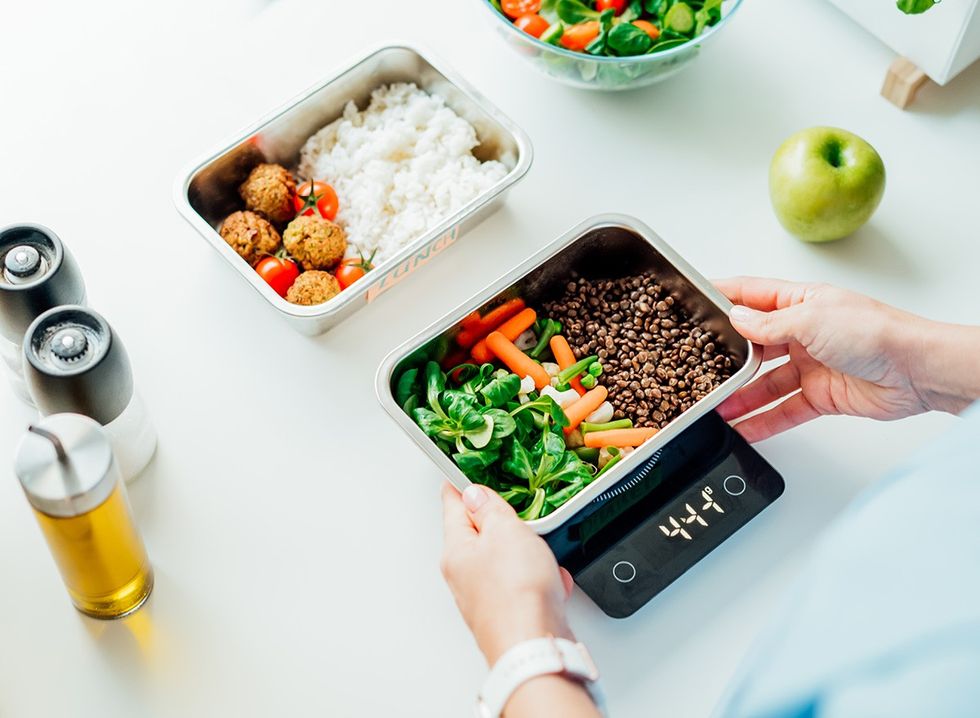Jenn Clayton is a Certified Weight Loss and Nutrition Coach and social media influencer. In her viral videos, she shares tips and tricks on how to lose weight — fast. “Today we're talking about how to lose 20 pounds as fast as possible,” she says in the clip. She also reveals that she lost “just under 140 pounds” by counting macros and calories. Here is exactly how she did it.
Lifestyle Changes Can Help You Lose Weight Fast and Keep It Off

“Losing weight is challenging whether you're trying to lose five pounds or 20 pounds, and we know that steady weight loss keeps the weight off. Fast weight loss doesn't always keep the weight off long term, but there are definitely some healthy lifestyle changes that you can make while losing weight that will ensure that you do it quickly and keep it off long term,” says Jenn.
Set Realistic Expectations, Losing One to Two Pounds a Week

“The first thing we always wanna do when we're setting out to lose weight is set expectations that are safe and reasonable. Losing weight safely typically means about one to two pounds per week. So, anywhere from 52 to 104 pounds lost safely over the course of one year. A balanced, nutritious diet moving your body, this is how you're going to keep those 52 or 104 pounds off long term,” she says.
1. Count Calories
Shutterstock
“Tip number one to drop weight quickly is to count your calories,” says Jenn. “Basically, weight loss is going to occur when you take in less than you're putting out, whether that's in your day-to-day life exercise included, not exercise included because you don't have to exercise to lose weight. It's all about how many calories in versus calories out.”
Have Your Macros and Calories Done
“The best way to know what your calorie consumption would be for steady weight loss is to have your personalized macros and calories done,” she says. “I follow my own macros and calories, and that's led to my almost 140-pound weight loss.”
2. Drink More Water

Number two is to drink more water. “Now, we hear this all the time: of course, drinking water is going to hydrate you. It's going to help with your hair, your skin, your nails, and just how you feel overall,” she says. “But drinking water actually has big benefits for weight loss.”
And, Swap It Out Sugary Drinks with It

“Part of the reason for this is you're going to be swapping beverages with calories for water, so things like alcohol, soda, pop juices, teas, energy drinks, swap those out for water that's going to save you calories. And remember we talked about calories and calories out, and it's going to hydrate. You flush everything out of your body, which leads to weight loss. The other great benefit of water is it's going to help you keep full. Water sits in your belly, takes up space in your belly, so it's going to help keep you fuller for longer,” she says.
3. Amp Up Your Protein Intake

“Number three, and this is probably the most important of all of this, and this is to increase your protein intake,” says Jenn. “Protein is king when it comes to weight loss. Again, your protein intake is going to vary from anybody else. The protein that you need every day is specialized for you, and that is part of that macro and calorie calculation.”
Protein Is Harder to Digest, So It Burns More Calories
“Protein is the hardest macronutrient for your body to digest, so it's harder than carbs. It's harder than fat. And when our body is digesting protein, it's burning calories. The act of digesting food burns calories. So, if it takes longer to digest protein, we're going to burn more calories in the process. And I don't know about you, but burning calories just digesting my food sounds pretty good. Not to mention, protein will keep you fuller for longer and satisfied between meals. So make sure that protein is part of every meal and snack,” she says.
4. Reduce Refined Carbohydrates

Number four is to reduce your refined carbohydrate intake. “Now, this doesn't mean eliminating carbs altogether or restricting carbs. We really want to focus on slow-digesting carbs. Those are going to be the carbs that have fiber,” she says.
Slow Digesting Carbs Should Be 80 Percent of Your Carb Intake

She recommends things like rolled oats, sprouted bread, and quinoa. “Those are slow-digesting carbs. They should make up about 80% of your carb intake, and then that other 20% sitting over here can be some of those fast-digesting carbs like rice cakes, chips, crackers, and cookies. Those types of things are okay to have in moderation. But if we reduce those processed carbs and really focus on unrefined slow digesting carbs, again, it will keep us fuller for longer, and it takes our body longer to digest, therefore burning more calories,” she says.
5. Lift Weights

Number five, start lifting weights. “I can't stress how important this is. Now, this doesn't mean that you have to go to the gym and do a 150-pound deadlift. You can actually focus on lightweights with high reps,” she suggests.
You Will Build Lean Muscle

“This is going to build lean muscle. Lean muscle burns calories at rest. So the more lean muscle you have on your body, the more calories you're going to burn, doing absolutely nothing. So, sitting around watching TV, you're burning calories with that lean muscle, and the only way to build lean muscle is to lift weights. Not to mention, when we're experiencing a calorie deficit and we lose weight, remember that weight is made up of water, fat, and lean muscle. We're going to lose some of our lean muscle. So we want to make sure that we can maintain and build as much as possible while losing weight. And remember, the amount of lean muscle in our body decreases as we age. So lifting weights is even more important as we get older,” says Jenn.
6. Eat More Fiber

Number six, eat more fiber. This goes right along with eating more protein. It's going to help keep you fuller for longer. And when we have a higher protein diet, we can have issues going number two, and by eating enough fiber that's going to alleviate those issues.
Here Are Some Great Sources

She also points out that fiber fills you up. “Not to mention the benefits of keeping us full. Fruits, vegetables, whole grains, nuts, and seeds, these are all amazing sources of fiber,” she says.
7. Follow a Sleep Schedule

Number seven, follow a sleep schedule. “Sleep is so important for weight loss, maybe even as important as being in a calorie deficit. When we lack sleep, our body wants energy. The energy we would have gotten from getting enough sleep increases the cortisol levels in our body, which makes us crave foods that give us energy. And what are those foods? Fast digesting carbs, cakes, cookies, crackers, candy, sugar, things that give our body instant energy,” she says.
Practice Sleep Hygiene with These Tips

“Some tips to improve your sleep are getting seven to eight hours of sleep each night, practicing a calming bedtime ritual before bed, such as reading or taking a relaxing shower, going to bed and waking up at the same time each day, even on the weekends,” she continues. “Limiting screen time before bed, minimizing your intake of caffeine and large meals before bed, and reducing sources of light noise. And lastly, keep the room where you sleep at a cool temperature. These are really, really important facets in getting in your sleep, which leads ultimately to faster weight loss.”
8. Set Goals and Stay Accountable

Number eight, set a reasonable goal and stay accountable. “Consistency is key. Consistency over perfection,” she says. “Whatever goal you have for yourself, it should be reasonable, and it should keep you motivated. When I was in the bulk of my weight loss journey, I always had a goal of reaching the next weight decade, 190 pounds two, a hundred eighty-two, a hundred seventy. That was my goal.”
Reward Yourself

“Every time I reached a new weight decade, I rewarded myself with something not related to food that helped keep me motivated, helped keep me accountable, and I was very consistent in not only the foods that I chose but also moving my body regularly,” she reveals. “Set realistic and small goals that eventually lead to a big goal because that's really what's going to keep you motivated. Consistency over perfection. That's the key to weight loss.”
9. Add Cardio to Your Routine

Number nine, add some cardio to your routine. “This doesn't mean you have to go to the gym and sweat it out for hours upon hours. You can do some simple cardio that's going to help burn extra calories and remember, calories in, calories out. That's how we lose weight.”
RELATED: 11 Signs Ozempic Is Not for You
Here Are Examples of Cardio to Do

“Some great examples of cardio that you can add to your day are things like walking, running, jumping, rope, rowing, hiking, and biking. Maybe 20 minutes three times a week is a great place to start. Just moving our body overall not only helps with mobility, flexibility, maintaining lean muscle but also helps with weight loss,” she says.
10. Eat Slowly and Mindfully

Number 10 is to eat slowly, is to eat slowly and mindfully. “Don't be distracted when you're eating. Turn off the tv, and put your phone away. Really focus on your food. Take small bites and chew them really well. I know that I'm a fast eater, so what works for me is setting my silverware down between bites. That way, I actually have to focus on chewing what's in my mouth, swallowing that, and then picking up my silverware again for the next bite. It's actually recommended to chew your food about 20 times before swallowing,” she says.
Eliminate Distractions

“Eliminating any distractions is going to lead to mindful eating, and you're going to enjoy your food. Eat it slower, which sends a signal from your stomach to your brain that you've consumed. Food keeps you full, you don't overeat, and it's a great way to really enjoy the amazing foods that you're eating,” she points out.
Losing 20 Pounds Is Stressful, But Doable

“Losing 20 pounds or really losing any pounds is very, very stressful. It can be very frustrating, but there are some things that you can do in your day-to-day life that not only speed up your weight loss but help you keep it off long term,” she says at the end of the clip.
Talk to Your Doctor First

“Make sure that you talk with your doctor before starting any new exercise routine. And remember consistency over perfection. We're not going to be perfect on our weight loss journey. Really, truly, 80% of eating on plan and 20% of eating off of plan are going to lead to amazing quick results with weight loss,” she continues.
RELATED: 5 Ways to Speed Up Your Metabolism
Be Patient
Finally, be patient. “Patience is the key to determination and motivation. Remember, setting small goals that lead to a big goal will keep you motivated, get the weight off, and keep it off long term,” she says. And if you enjoyed this article, take advantage of these 15 Quick Ways to Lose Body Fat Percentage in a Week.
















 Meal PlanningShutterstock
Meal PlanningShutterstock Shutterstock
Shutterstock Greek Yogurt with Berries and Chia Seeds
Greek Yogurt with Berries and Chia Seeds Lean Ground BeefShutterstock
Lean Ground BeefShutterstock Collagen ProteinShutterstock
Collagen ProteinShutterstock Bone BrothShutterstock
Bone BrothShutterstock 5. Broth (chicken or vegetable): 15 caloriesShutterstock
5. Broth (chicken or vegetable): 15 caloriesShutterstock 2. Cottage Cheese (14g protein per 1/2 cup)Shutterstock
2. Cottage Cheese (14g protein per 1/2 cup)Shutterstock Shutterstock
Shutterstock
 Amp Up Your Protein IntakeShutterstock
Amp Up Your Protein IntakeShutterstock Trying to Get Protein From Too Many SourcesShutterstock
Trying to Get Protein From Too Many SourcesShutterstock
 Shutterstock
Shutterstock Shutterstock
Shutterstock Shutterstock
Shutterstock Shutterstock
Shutterstock Shutterstock
Shutterstock Shutterstock
Shutterstock Shutterstock
Shutterstock Shutterstock
Shutterstock Shutterstock
Shutterstock
 Shutterstock
Shutterstock

 Shutterstock
Shutterstock Shutterstock
Shutterstock Shutterstock
Shutterstock Shutterstock
Shutterstock


 I'm a Nutritionist and These 9 High-Protein Snacks Keep My Clients Full While Losing 50 Pounds
I'm a Nutritionist and These 9 High-Protein Snacks Keep My Clients Full While Losing 50 Pounds
 Shutterstock
Shutterstock 2. Processed FoodsShutterstock
2. Processed FoodsShutterstock Shutterstock
Shutterstock Shutterstock/Prostock-studio
Shutterstock/Prostock-studio Shutterstock
Shutterstock Pro TipsShutterstock
Pro TipsShutterstock Shutterstock
Shutterstock Shutterstock
Shutterstock Shutterstock
Shutterstock Shutterstock
Shutterstock Most Women on GLP-1s Are Making a Few Common MistakesShutterstock
Most Women on GLP-1s Are Making a Few Common MistakesShutterstock Soda and Sugary DrinksShutterstock
Soda and Sugary DrinksShutterstock Shutterstock
Shutterstock Eat BreakfastShutterstock
Eat BreakfastShutterstock And Improve Insulin SensitivityShutterstock
And Improve Insulin SensitivityShutterstock Belly Flab Strip Tip: Sugar and Fat Calories Leave Its Mark on Your BodyShutterstock
Belly Flab Strip Tip: Sugar and Fat Calories Leave Its Mark on Your BodyShutterstock Shutterstock
Shutterstock The Drugs Mimic the GLP-1 Hormone Naturally Produced by the BodyShutterstock
The Drugs Mimic the GLP-1 Hormone Naturally Produced by the BodyShutterstock 3. Deep-Fried ItemsShutterstock
3. Deep-Fried ItemsShutterstock